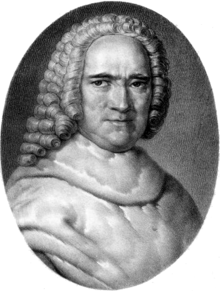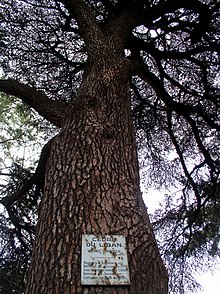Bernard de Jussieu

Bernard de Jussieu (born August 17, 1699 in Lyon , † November 6, 1777 in Paris ) was a French botanist . Its official botanical author abbreviation is " B.Juss. "
Live and act
Bernard de Jussieu was a son of the Lyons pharmacist Laurent de Jussieu (1651-1718) and his wife Lucie cousin. Two of his brothers were the botanists Antoine and Joseph de Jussieu . Bernard de Jussieu received his first training at the Jesuit school in Lyon, which included in particular a study of rhetoric . In 1714 he moved to Paris to live with his brother Antoine , who had held the chair of botany at the Jardin du Roi for several years , to continue his education there. In 1716 Bernard de Jussieu accompanied his brother on a trip through France, Spain and Portugal, during which his interest in botany awoke. After his return, he herbarized the area around Lyon for some time and finally began studying medicine at the University of Montpellier . There in 1719 Bernard de Jussieu acquired under Antoine Magnol (1676-1759) with the work De naturali secretione bilis in jecore the degree of a bachelor's degree in medicine. He then practiced as a doctor for a while, but found no pleasure in this activity. After the death of Sébastien Vaillant , Bernard de Jussieu was appointed sub-demonstrator ("sous-demonstrateur de l'extérieur des plantes") on September 30, 1722 at the Jardin du Roi and was responsible for the garden and the greenhouses.
In 1724 Bernard de Jussieu received a license from the medical faculty of the University of Paris , which followed there in 1726 his doctorate in medicine. In the meantime he had published an annotated edition of Joseph Pitton de Tournefort 's Histoire des plantes qui naissent dans les environs de Paris on the plants growing in the vicinity of Paris. The excursion conducted by Bernard de Jussieu was very popular. His lectures at the Jardin du Roi influenced, for example, Michel Adanson , Jean-Étienne Guettard , Henri Louis Duhamel du Monceau , Louis Guillaume Le Monnier , André Thouin , the gardeners Claude (1705–1784) and Antoine Richard (1737–1807) and his brother Joseph and his nephew Antoine-Laurent . Among the audience of his lectures were, for example, Georges-Louis Leclerc de Buffon , Chrétien-Guillaume de Lamoignon de Malesherbes and Carl von Linné .
Bernard de Jussieu traveled to England twice. From there he introduced the Lebanon cedar to France in 1734 . In 1739 he published his first memoire on the genus of pill ferns . In further treatises he dealt with the genera Lemma and Litorella . However, he never prepared his botanical lectures and his ideas for the classification of plants for publication. As supervisor of the garden at Petit Trianon , Bernard de Jussieu supervised the creation of a botanical garden in 1758 in which an attempt was made to represent the natural system of plants by grouping plants of similar genera. He used his further development of the Fragmenta methodi naturalis , which Carl von Linné had published in Classes Plantarum in 1738 . This system was not printed until 1789 in Antoine-Laurent de Jussieu 's Genera Plantarum work .
On July 31, 1725, the Académie des Sciences elected him as the successor to Antoine-Tristan Danty d'Isnard as its member as "Adjoint botanist". On March 16, 1739 he moved up for Henri Louis Duhamel du Monceau as "Associé botaniste" and was already on May 20, 1739 as a replacement for the late Michel-Louis Reneaume (1675-1739) "Pensionnaire". In 1753 Bernard de Jussieu was deputy director and in 1754 director of the Académie des sciences.
At the suggestion of the doctor James Jurin (1684-1750) he was elected to the Royal Society on June 22, 1727 . On November 18, 1749, Bernard de Jussieu was accepted as a foreign member of the Swedish Kungliga Vetenskapsakademien .
Dedication names
William Houstoun named a plant genus Jussieva in honor of him and his brothers Antoine de Jussieu and Joseph de Jussieu . Carl von Linné , however, assigned this to Jatropha and named after all three brothers the genus Jussiaea of the plant family of the evening primrose family (Onagraceae), which, however, according to the system used here, has merged into the genus of the hayweed ( Ludwigia ).
The plant species Bernardia from the Spurge Family (Euphorbiaceae), introduced by Philip Miller in the 4th edition of his work The Gardeners Dictionary in 1754 , was probably also named after him.
The asteroid (9470) Jussieu was named in honor of him and Antoine-Laurent , Joseph and Adrien-Henri-Laurent de Jussieu.
Fonts (selection)
- As editor and editor
- Joseph Pitton de Tournefort: Histoire Des Plantes Qui Naissent Aux Environs De Paris Avec leur usage dans la Medecine . 2 volumes, 2nd revised edition, Musier, Paris 1725 ( volume 1 , volume 2 ).
- Own writings
- De naturali secretione bilis in jecore . H. Pech, Montpellier 1719 (online) .
- Catalog des arbres, et arbrisseau qui se peuvent élever en pleine terre aux environs de Paris . J. Bullot, Paris 1735 (online) .
- Examen des causes qui ont altéré l'eau de la Seine, pendant la sécheresse de l'année 1731 . In: Histoire de l'Académie royale des sciences. Année 1733 . Paris 1735, pp. 351-360 (online) .
- Histoire d'une Plante, connuë par les Botanistes sous le nom de Pilularia . In: Histoire de l'Académie royale des sciences. Année 1739 . Paris 1741, pp. 240-256 (online) .
- Histoire du Lemma . In: Histoire de l'Académie royale des sciences. Année 1740 . Paris 1742, pp. 263-275 (online) .
- Sur une espèce d'Ouate ou de matière cotonneuse trouvée au fond d'un Étang . In: Histoire de l'Académie royale des sciences. Année 1741 . Paris 1744, pp. 85-86 (online) .
- Observation nouvelle sur les Fleurs d'une espèce de Plantain nommée par M. de Tournefort dans ses Élémens de Botanique, Plantago palustris gramineo folio monanthos Parisiensis, p. 104 . In: Histoire de l'Académie royale des sciences. Année 1742 . Paris 1745, pp. 131-138 (online) .
- Examen de quelques Productions marines qui ont été mises au nombre des Plantes, & qui sont l'ouvrage d'une sorte d'Insectes de Mer . In: Histoire de l'Académie royale des sciences. Année 1742 . Paris 1745, pp. 290-302 (online) .
- [ Observations on the effets de l'eau de Luce versus the morsure des vipères et des serpene ]. In: Histoire de l'Académie royale des sciences. Année 1747 . Pp. 54-56 (online) .
- Posthumously
- Bernardi de Jussieu Ordines Naturales in Ludovici XV Horto Trianonensi dispositi anno 1759 . In: Antoine-Laurent de Jussieu: Genera Plantarum, secundum ordines naturales disposita juxta methodum in Horto Regio Parisiensi exaratam . Paris 1789, pp. LXIII-LXX (online) .
literature
- Marie-Jean-Pierre Flourens: The Jussieus and the Natural Method . In: Annual report of the Board of Regents of the Smithsonian Institution . GPO, Washington 1888, pp. 246-276 (online) .
- Adrien de Jussieu : Caroli a Linné ad Bernardum de Jussieu ineditae, et mutuae Bernardi ad Linnaeume Epistolae . In: Memoirs of the American Academy of Arts and Sciences . Second Series, Volume 5, 1855, pp. 179-234 (online) .
- Antoine Magnin: Prodrome d'une histoire des botanistes Lyonnais . In: Bulletin de la Société botanique de Lyon , Volume 31, 1906, pp. 28-29 (online) .
- Frans Antonie Stafleu : Jussieu, Bernard De . In: Complete Dictionary of Scientific Biography . Volume 7, Charles Scribner's Sons, Detroit 2008, pp. 199-200 (online) .
- Frans Antonie Stafleu, Richard Sumner Cowan: Taxonomic literature. A selective guide to botanical publications and collections with dates, commentaries and types . Volume 2: H-Le, 2nd edition, Utrecht 1979, ISBN 90-313-0343-7 , pp. 479-480 (online) .
- James Edward Smith : A Selection of the Correspondence of Linnaeus, and other Naturalists, from the original Manuscripts . Volume 2, London 1821, pp. 208-227 (online) .
- Bernard de Jussieu and the Petit Trianon . In: Roger Lawrence Williams: Botanophilia in Eighteenth-Century France. The Spirit of the Enlightenment . Kluwer Academic Publishers, Dordrecht 2001 ISBN 0-7923-6886-X , pp. 31-44.
Individual evidence
- ↑ Pierre Labrude: L'apothicaire Laurent de Jussieu et sa famille . In: Revue d'Histoire de la Pharmacie . Volume 78, Number 284, 1990. pp. 43-44 (online) .
- ↑ Louis Dulieu: La médecine à Montpellier . Volume 3, Les presses universelles, 1986, p. 427.
- ↑ Carl von Linné: Classes Plantarum . Wishoff, Leiden 1738, col. 485-488 ( online ).
- ↑ Les membres du passé dont le nom commence par J .
- ↑ EW Dahlgren (Ed.): Kungl. Svenska Vetenskapsakademien. Personförteckningar, 1739-1915 . Almqvist & Wiksells, Stockholm 1915, p. 118 (online) .
- ↑ Carl von Linné: Genera Plantarum . Leiden 1742, p. 366.
- ^ Carl von Linné: Critica Botanica . Leiden 1737, p. 93.
- ↑ Carl von Linné: Species Plantarum . Leiden 1753, p. 388.
- ^ Philip Miller: The Gardeners Dictionary . 4th edition, 1754, volume 1, without page numbers, (online) .
- ^ Frans Antonie Stafleu, Richard Sumner Cowan: Taxonomic literature. A selective guide to botanical publications and collections with dates, commentaries and types . Volume 2: H-Le, 2nd edition, Utrecht 1979, ISBN 90-313-0343-7 , p. 480 (online) .
- ^ Lutz D. Schmadel: Dictionary of Minor Planet Names. Volume 1, 5th revised and expanded edition. Springer, Berlin / Heidelberg / New York 2003, ISBN 3-540-00238-3 , p. 693.
Web links
- Author entry and list of the plant names described for Bernard de Jussieu at the IPNI
- Exchange of letters between Bernard de Jussieu and Carl von Linné
- Entry to Jussieu; Bernard de (1699 - 1777) in the Archives of the Royal Society , London
| personal data | |
|---|---|
| SURNAME | Jussieu, Bernard de |
| BRIEF DESCRIPTION | French botanist |
| DATE OF BIRTH | 17th August 1699 |
| PLACE OF BIRTH | Lyon |
| DATE OF DEATH | November 6, 1777 |
| Place of death | Paris |
